The Cité Falguière is a cul-de-sac located in Paris’ 15th arrondissement, near Montparnasse.
It was erected during the late 19th century as an initiative of Jules-Ernest Bouillot, practitioner for sculptor and painter Alexandre Falguière. Bouillot had the idea of building low-cost studios that could be rented to artists with little resources. To this intent, in the 1860s he purchases a land at Chemin des Fourneaux and in the 1870s the first artist studios are built. The ateliers are set-up in a cul-de-sac separated from the Rue (previously Chemin) des Fourneaux by a wooden fence. The cul-de-sac is named Impasse Frémin after the first owner of the studios, Mrs. Frémin. A few years later, the street changes its name to Cité des Fourneaux. In 1901, Rue des Fourneaux takes its current name, Rue Falguière, and the cul-de-sac becomes Cité Falguière.
Located between the famous artist residence La Ruche and the increasingly vibrant area of Montparnasse, Cité Falguière served in the early years of the 20th century as work and/or living place to several modern artists, including Amedeo Modigliani, Chaïm Soutine, Tsuguharu Foujita, Constantin Brancusi, and Paul Gauguin.
Almost penniless painters, sculptors, and writers came from around the world attracted by the creative atmosphere of the Montparnasse neighborhood along with the cheap rents at artist studios such as La Ruche and Cité Falguière. Living without running water, in damp, unheated studios, seldom free of rats, many sold their works for a few francs just to buy food. Writer and filmmaker Jean Cocteau once said that “poverty was a luxury in Montparnasse”. First promoted by art dealers such as Daniel-Henry Kahnweiler, today these same artworks sell for millions of euros.
Urban renewal of the street began in the 1960s and artist studios were gradually destroyed to give way to residential buildings. Of the original structures, only numbers 9 and 11 are still standing today (shown below). Both buildings continue to house artist studios.
La cité Falguière à Paris, vue depuis la fin de l’impasse by Ralf Treinen, 20 May 2012 – Creative Commons License
This is a shot from the end of the Cité, showing the only remaining structures, numbers 9 and 11. Soutine painted in number 11 (on the right side of the picture).
Cité Falguière by Daniel Angeli, 1967
This picture was taken by Daniel Angeli right before the demolition of the emblematic Hôtel – Villa Falguière located at the end of the cul-de-sac, number 14. On the walls a handwritten tag displays “Here lived Picasso, Soutine, Modigliani, Foujita” (however, it does not seem that Picasso lived in the Cité Falguière, although he did live in the Montparnasse neighborhood).
Another view of the Hôtel – Villa Falguière, 1947
Retrospective view of the Cité Falguière by Jacques Mauve
The above illustration shows the layout of the Cité in the 1910s. The Hôtel – Villa Falguière is the building at the end of the cul-the-sac, and the buildings surrounded by a dotted line are those still standing today, numbers 9 and 11.
View of Cité Falguière in 2013, showing number 14 at the end of the cul-de-sac, where the Hôtel – Villa Falguière previously stood
Entrance gate of Hôtel – Villa Falguière
Hôtel – Villa Falguière seen from number 13
The two following pictures from Parisienne de Photographie show the inner courtyards that can be seen on the left in Jacques Mauve’s illustration, around 1920-1930.
La cité Falguière où se trouvaient de nombreux ateliers d’artistes, vers 1920-1930 – © Albert Harlingue / Roger-Viollet
La cité Falguière, 72, rue Falguière – © Albert Harlingue / Roger-Viollet
One of the most notable residents of Cité Falguière was Soutine. Soutine was born in the Smilovichi shtetl of the Russian Empire (now in Belarus) as the tenth of eleven children. Many stories surround Soutine’s obscure and complex early years. Soutine himself admitted not knowing his precise birth date, and stories depict a conflicted relationship with his father. Soutine emigrated to Paris in the beginning of the 1910s, when he was around 20 years old.
In Paris, he met and became instantly a friend to Modigliani. For a period of time, the two artists lived under the same roof at the Cité. In 1916, Soutine’s friend and compatriot painter Pinchus Krémègne recites: “One day I arrived at around 11pm or midnight at the Cité Falguière. Modigliani had thrown away all the furniture because it had been infested with bedbugs. I entered… Modigliani and Soutine were lying on the floor. Of course, there was no light or gas. They held each a candle in their hands; Modigliani was reading Dante and Soutine, Le Petit Parisien.”
The following paintings by Soutine depict the Cité Falguière.
La Cité Falguière, Chaïm Soutine, oil on canvas, painted circa 1914
Les ateliers de la cité Falguière, Chaïm Soutine, oil on canvas, painted circa 1914
This last canvas shows the painter’s studio at number 11, still an artist studio today. The chimney in the back belonged to the Institut Pasteur whose buildings adjoin those of the Cité. The Institut Pasteur is still located next to the Cité but the chimney was demolished.
Number 11 has not changed much since the 1910s, as the following shot taken in October 2013 attests.
An inscription on the wall reads: “Dans cet atelier habita le peintre Chaïm Soutine” (“In this atelier lived the painter Chaïm Soutine”).

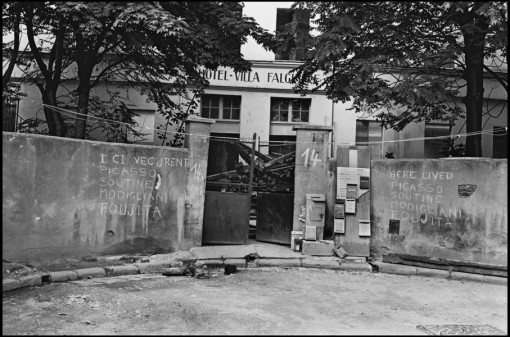
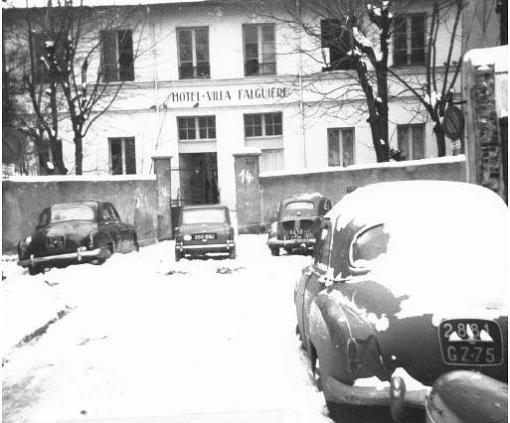

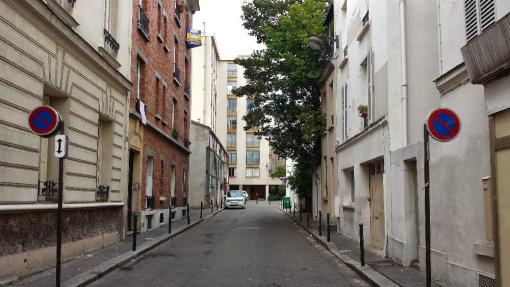


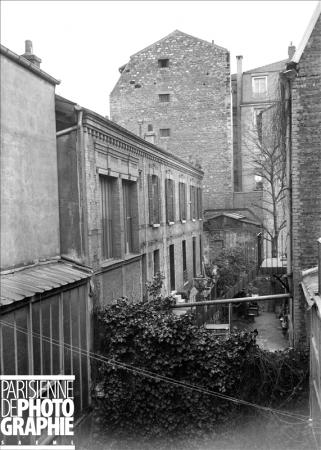
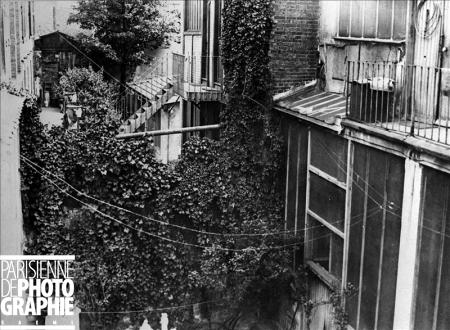

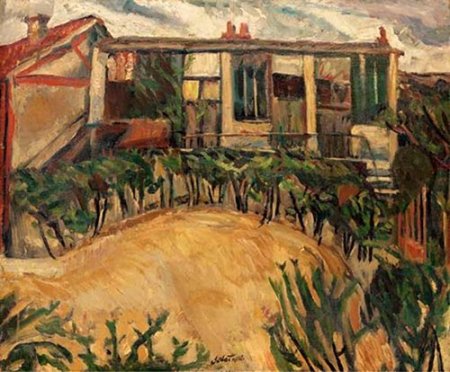



hello, do you know who is the owner of the painting
“Les ateliers de la cité Falguière,” today?
Hi Daniel! Sorry, I don’t know who’s the owner of the painting. I’ll let you know if I figure that out. And nice to know that you live in the Cité!
Very happy to have found this very informative Cité de La Falguière article with its precious photographic
material after having visited the place only two days earlier on a visite to Paris. I was there doing research on Moissey (also Moissi etc) Kogan, another Russian Jew, friend of Soutine, and a sculptor still known far too little – in spite of the fact that both the Musée d’Art Moderne and the Musée Rodin have works of his, and that he was befriended with both Rodin and Maillol. His oeuvre which is almost exclusively devoted to the beauty of the female body is comparatively small. There is however a monography on Moissey Kogan
(Katharina Henkel: Moissey Kogan, in German) which includes a work catalogue.He spent most of his life at No 14 Cité Falguière. In 1943 the Nazis got him, and he was murdered in Auschwitz the same year. He was married to a Polish Jew, Maryla Friedman, who earned both their living as a piano teacher. Having survived the Nazi rule, she probably continued to live in No 14. She died in 1954. I would appreciate any additional information someone might have on especially Moissey Kogan.
Wolfgang Heinzmann
Dear Wolfgang, it’s strange: the Census of 1946 still indicates that Moissey Kogan lives at 14 Cité Falguière. Alessandro De Stefani
Cité Falguière by Daniel Angeli, 1967: Cette photo me rappelle de nombreux souvenirs d’une bande de jeunes “marginaux” qui avaient élu domicile ce lieu délabré en attente de destruction. La voisine américaine déclamait “Katia, Ivan” pour rappeler ses enfants irrésistiblement attirés par la communauté conviviale des squatteurs. C’étaient Nicolas, Pierre, Anne, Élisabeth, Charly, Gérard, Yasmine et la visite des uns et des autres de genres différents. C’était la bohème insouciante! C’est loin.
Très intéressant. La Cité a tellement changé en l’espace de 60 ans !
Bonjour à tous,
J’effectue des recherches sur les modèles noirs Aïcha et Dal-Al qui ont posé à Montparnasse au début du 20e. Aïcha a apparemment vécu à la cité Falguière.
Savez-vous s’il existe des archives et/ou une association sur la cité Falguière ?
Merci !!
Isabelle
Pas à ma connaissance ! Je serais intéressée d’en savoir plus également.
Hello,my name is Matija Drljača and i am from Belgrade.My grandfather name was Lazar Drljača and he was academic painter.He lives in Paris, Cite Falguiere 14.
Lazar Drljača hung out with Modigliani.
I have Lazar document at that address…
You can visit FB. Page Lazar Drljaca.
My grandfather was academic painter and he lived in Paris from 1912 to 1916 at Cite Falguiere 14.
His name was Lazar Drljača
That’s very impressive, Matija. I just discovered another illustrious inhabitant of the Cité!
Congratulations.
Maybe you find something about my grandfather.
One Parisian lady is the owner of Lazar work.
Portret of the girl,
Oil on canvas.
As an appendix to my article on Modigliani at the Cité Falguière you will find a provisional list of the artists who lived there between 1906 and 1914: https://www.academia.edu/11436014/Modigliani_alla_Cité_Falguière_la_prima_fase_della_scultura_nel_suo_contesto_immediato
Thank you.
My Japanese Grand Father Key SATO lived around 1960-1964 at Cité Falguière> The French famous photographs Robert Doisneau took a picture of him there, found in a book called DOISNEAU Portraits d’Artistes.
Thrilled to hear about Key Sato. There is a footage on the Cité Falguière, including Sato, dating back to 1964. It is by the Austrian film maker Georg Stefan Troller.
Hi. Thank you for the information. Do you know how I could watch that film?
I also found some pictures of Key SATO at his atelier of cité Falguière with his muse Jacqueline Michel who was a student learning Japanese living nearby. She will later marry Ado, Key’s son, and she will have me. She is my mother in fact.
These photos are in the following link: http://archivesetdocumentation.centrepompidou.fr/ead.html?id=FRM5050-X0031_0000185#!{%22content%22:[%22FRM5050-X0031_0000185_FRM5050-X0031105546%22,false,%22%22]}
Search this title. SHU 2948 – 2997
Kei Sato chez lui, lieu non identifié.
I made it available through my facebook profile: https://m.facebook.com/adestefani